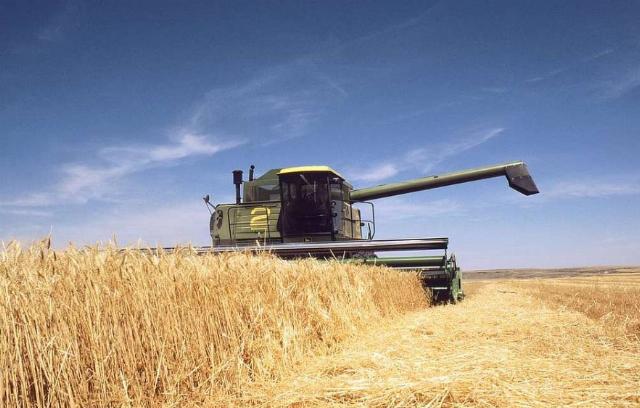Thank A Farmer
With the fall harvest advancing toward completion across the nation’s breadbasket, early reports by the Department of Agriculture predict a record-large corn crop of 16.8 billion bushels that is nearly 1.5 billion above the 2023 record.
U.S. corn, soybean, wheat, and rice crops look to continue a trend of remarkable growth in both output and productivity. This year, corn may yield a record 188.8 bushels per acre nationwide. Soybeans will also reach record-high yields of 53.5 bushels per acre; while wheat is forecast to improve to 53.3 bushels per acre with overall production just under a percent larger than last year. American farmers will again help feed a hungry planet that may approach 9.7 billion inhabitants by 2050.
Global agricultural trends reflect gains as well. Between 1961 and 2020, world agricultural output increased nearly fourfold. Production of corn, soybeans, rice, and wheat has seen steady increases for decades. Over the last 50 years, global population has more than doubled, yet global cereal production grew much faster than the world’s annual population growth rate of about 1%.
But abundances come with challenges. Plentiful supply depresses commodity prices on global markets, thus putting financial pressures on farmers. Due to rising costs, low crop prices, and fallout from trade wars and competition, economists project growers could see roughly $44 billion in net cash income losses from their 2025–26 crops. “There is too much corn,” said one analyst, to match demand. U.S. corn and soybean growers must now concern themselves with consumption of previous record-setting crops to foster future price increases.
If current economics of farming were not unnerving enough, Americans have been fed a steady diet of dire predictions of climate change with presumptions of human-caused global warming. Scientists speculate that storms and weather phenomena like extremes of drought, wind, heat, and rainfall will be more intense and frequent. Add pestilence, pollution, and fires, along with encroachment from human activity, and one is led to wonder how American farmers can survive to produce and even prosper.
Instead, the American farmer continually adapts to the climate -- and weather -- through changes in crop rotations, planting times, genetic selections, fertilizer choices, improved equipment, innovation, pest and water management, and shifts in areas of crop production, among other measures. They take advantage of an unmatched system of education, research, science, and technology in American universities and business that has evolved to support American agriculture. Farmers also make effective use of a responsive “agri-business” banking and finance system. On whole, American farmers are part of, and benefit from, a well-honed agricultural infrastructure that fosters advances in production and efficiency.
 By contrast -- in just one global example -- Africa, despite vast natural resources, including expanses of arable land, has the world’s highest incidence of undernourishment (estimated at near one in five people). Africa has an estimated 24% of the world’s agricultural land and 17% of the arable land, yet agricultural output is only 10% of global totals. Agricultural production remains dismal, further undermining Africa’s future and economic growth.
By contrast -- in just one global example -- Africa, despite vast natural resources, including expanses of arable land, has the world’s highest incidence of undernourishment (estimated at near one in five people). Africa has an estimated 24% of the world’s agricultural land and 17% of the arable land, yet agricultural output is only 10% of global totals. Agricultural production remains dismal, further undermining Africa’s future and economic growth.
One major factor is the low productivity of land. Crop yields in the region are much lower than in other parts of the world, with the average being half of India's and one-fifth the U.S.'s. Africa must import food staples largely because continental food production, supply, and consumption systems do not function optimally. Africa imports near 85% of its food from outside the continent, while the projected import bill for that sustenance could total US$110 billion in 2025.
Maybe more importantly, consider that no African nation can provide its farmers with the political and societal stability needed to support a similarly developed agricultural infrastructure. Instead of national development and improving the lives of Africans, Sub-Saharan Africa has become the epicenter of global jihadist terrorism. The entire African continent faces serious challenges to political stability, with many countries experiencing military rule, postponed elections, and civil unrest. Consider nations such as Zimbabwe (once Africa’s breadbasket), Nigeria, and South Africa as illustrative of the challenges. Zimbabwe holds the continent’s most fertile farmland, yet a recent report explained: “a onetime net exporter of maize, cotton, beef, tobacco, roses, and sugarcane,” the country is only now recovering from decades of corrupt autocratic rule. The other nations, which should be natural agricultural centers and producers, must instead confront current alarming threats to political stability and even survival.
Consider the possibilities if African farmers could bring to bear similar resourcefulness, science, technology, finance, know-how, entrepreneurship, and work ethic as their American counterparts. What if Africa’s arable and unexploited croplands could be farmed to standards like those in America’s Midwest and raised to sustainable production levels?
It is not "climate change," weather phenomenon, or human encroachment that threatens future generations. Humans adapt to their environment and adjust agriculture to feed the people. The global threat is poor, non-functioning governance, but more precisely, autocratic, authoritarian, and corrupt regimes not acting for the “common good.” Poor governance has made more people's lives worse than anything climate change or weather extremes will ever do. That is the national security threat; that is the greatest threat to global agriculture and food production.
When offering thanks for our blessings before upcoming holiday meals, remember the American farmer and their accomplishments we all too often take for granted. Thank farmers for their own unique service to the nation.
Colonel Chris J. Krisinger, USAF (Ret) was born and raised in a Western Iowa farming community. During his Air Force career, he served in policy advisory positions at the Pentagon and twice at the Department of State